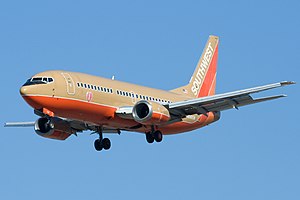
Back Boeing 737 Classic AN بوينغ 737 كلاسيك Arabic Boeing 737 Classic Catalan Boeing 737 Classic Czech Boeing 737 Classic Spanish بوئینگ ۷۳۷ کلاسیک Persian Boeing 737 Classic French Boeing 737 Classic Galician Boeing 737 Classic Croatian Boeing 737 Classic ID
| Boeing 737 Classic 737-300/-400/-500 | |
|---|---|
 Stretched from the original series and re-engined with wider CFM56 turbofans, the initial, midsize 737-300 (pictured) is the most common variant | |
| General information | |
| Type | Narrow-body aircraft |
| National origin | United States |
| Manufacturer | Boeing Commercial Airplanes |
| Status | In service |
| Primary users | UTair |
| Number built | 1,988[1] |
| History | |
| Manufactured | 1981–2000[1] |
| Introduction date | November 28, 1984, with USAir |
| First flight | February 24, 1984 |
| Developed from | Boeing 737 Original |
| Developed into | Boeing 737 Next Generation |
The Boeing 737 Classic is a series of narrow-body airliners produced by Boeing Commercial Airplanes, the second generation of the Boeing 737 series of aircraft. Development began in 1979 and the first variant, the 737-300, first flew in February 1984 and entered service that December. The stretched 737-400 first flew in February 1988 and entered service later that year. The shortest variant, the 737-500, first flew in June 1989 and entered service in 1990.
Compared to the original series, the classic series was re-engined with the CFM56, a high-bypass turbofan, for better fuel economy and had upgraded avionics. With a 133,500–150,000 lb (60.6–68.0 t) MTOW, it has a range of 2,060 to 2,375 nautical miles [nmi] (3,815 to 4,398 km; 2,371 to 2,733 mi). At 102 feet (31 m) the -500 is similar in length to the original 737-200 and can fly 110 to 132 passengers. The 110-foot-long (34 m) -300 can seat 126 to 149 passengers while the 120-foot-long (37 m) -400 accommodates 147 to 168 seats.
It competed with the McDonnell Douglas MD-80 series, then with the Airbus A320 family which prompted Boeing to update its offer with the 737 Next Generation, thus designating the -300/400/500 variants as the 737 Classic. In total, 1,988 aircraft were delivered from 1984 until production ended in the year 2000: 1,113 -300s, 486 -400s and 389 -500s.
- ^ a b Endres, Günter (2001). The Illustrated Directory of Modern Commercial Aircraft. Osceola, Wisconsin: MBI Publishing Company. pp. 126, 128–19. ISBN 0-7603-1125-0.